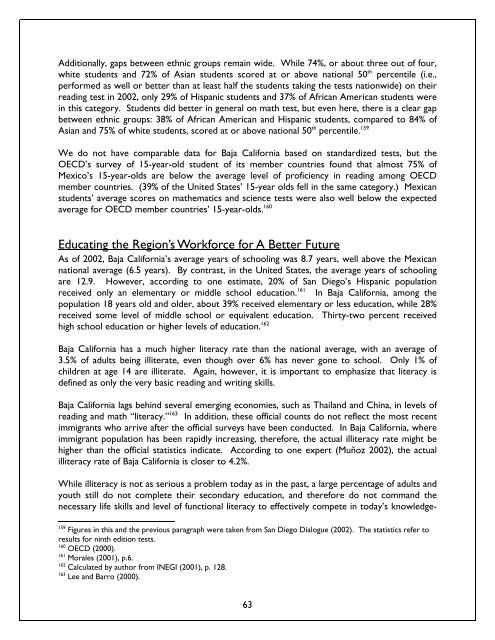Blurred Borders - International Community Foundation
Blurred Borders - International Community Foundation
Blurred Borders - International Community Foundation
You also want an ePaper? Increase the reach of your titles
YUMPU automatically turns print PDFs into web optimized ePapers that Google loves.
Additionally, gaps between ethnic groups remain wide. While 74%, or about three out of four,<br />
white students and 72% of Asian students scored at or above national 50 th percentile (i.e.,<br />
performed as well or better than at least half the students taking the tests nationwide) on their<br />
reading test in 2002, only 29% of Hispanic students and 37% of African American students were<br />
in this category. Students did better in general on math test, but even here, there is a clear gap<br />
between ethnic groups: 38% of African American and Hispanic students, compared to 84% of<br />
Asian and 75% of white students, scored at or above national 50 th percentile. 159<br />
We do not have comparable data for Baja California based on standardized tests, but the<br />
OECD’s survey of 15-year-old student of its member countries found that almost 75% of<br />
Mexico’s 15-year-olds are below the average level of proficiency in reading among OECD<br />
member countries. (39% of the United States’ 15-year olds fell in the same category.) Mexican<br />
students’ average scores on mathematics and science tests were also well below the expected<br />
average for OECD member countries’ 15-year-olds. 160<br />
Educating the Region’s Workforce for A Better Future<br />
As of 2002, Baja California’s average years of schooling was 8.7 years, well above the Mexican<br />
national average (6.5 years). By contrast, in the United States, the average years of schooling<br />
are 12.9. However, according to one estimate, 20% of San Diego’s Hispanic population<br />
received only an elementary or middle school education. 161 In Baja California, among the<br />
population 18 years old and older, about 39% received elementary or less education, while 28%<br />
received some level of middle school or equivalent education. Thirty-two percent received<br />
high school education or higher levels of education. 162<br />
Baja California has a much higher literacy rate than the national average, with an average of<br />
3.5% of adults being illiterate, even though over 6% has never gone to school. Only 1% of<br />
children at age 14 are illiterate. Again, however, it is important to emphasize that literacy is<br />
defined as only the very basic reading and writing skills.<br />
Baja California lags behind several emerging economies, such as Thailand and China, in levels of<br />
reading and math “literacy.” 163 In addition, these official counts do not reflect the most recent<br />
immigrants who arrive after the official surveys have been conducted. In Baja California, where<br />
immigrant population has been rapidly increasing, therefore, the actual illiteracy rate might be<br />
higher than the official statistics indicate. According to one expert (Muñoz 2002), the actual<br />
illiteracy rate of Baja California is closer to 4.2%.<br />
While illiteracy is not as serious a problem today as in the past, a large percentage of adults and<br />
youth still do not complete their secondary education, and therefore do not command the<br />
necessary life skills and level of functional literacy to effectively compete in today’s knowledge-<br />
159<br />
Figures in this and the previous paragraph were taken from San Diego Dialogue (2002). The statistics refer to<br />
results for ninth edition tests.<br />
160<br />
OECD (2000).<br />
161<br />
Morales (2001), p.6.<br />
162<br />
Calculated by author from INEGI (2001), p. 128.<br />
163<br />
Lee and Barro (2000).<br />
63















